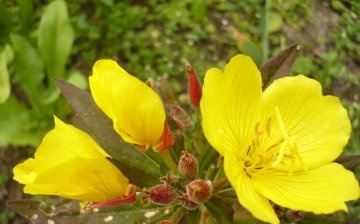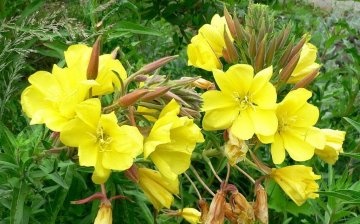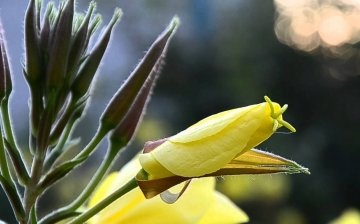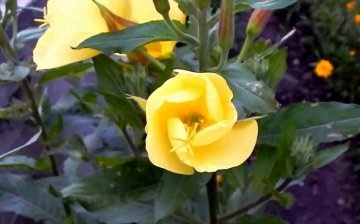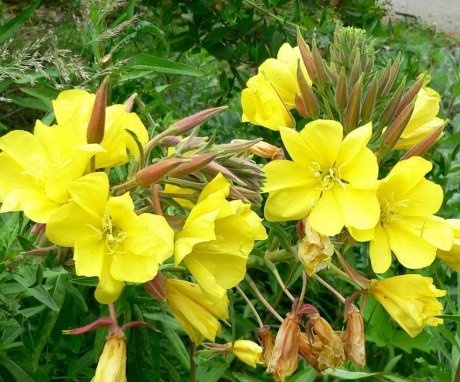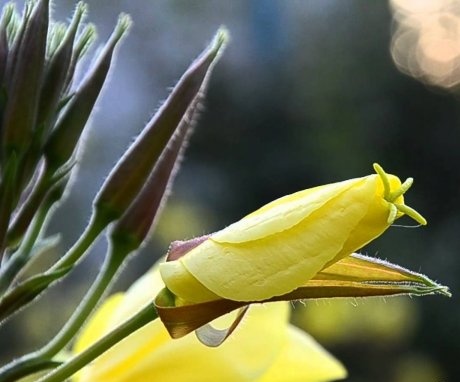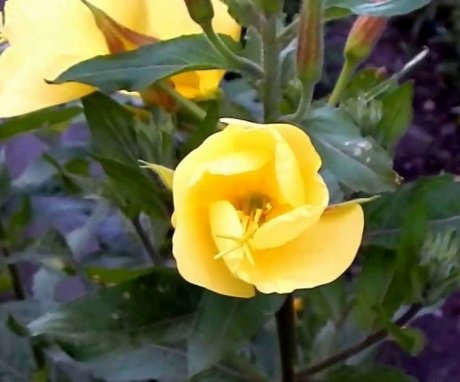Evening primrose (night candle): cultivation and use
Enotera belongs to the Cyprian family. In total, about 80 species of this plant are known. Enotera two-year-old grows wild in Europe.
Content:
Description and types of plants
Enotera has several names. The Germans call it a night candle. This is due to the fact that it dissolves its delicate fragrant flowers in the evening, before sunset. If you stand near the bush at this time, you can see a real miracle. Petals on one of the flowers unfold quickly, releasing cotton.
The flower opens completely in a few seconds.
Before we had time to look at this miracle, another pop was heard. You wait with bated breath, trying to guess which flower will bloom next. And so on until all the buds ready to bloom open. Until nightfall, bright large evening primrose flowers seem to glow on the candlestick stem. By the afternoon of the next day, they fade, and in the evening everything repeats again. In cloudy weather, the flowers do not close all day.
Enotera - unpretentious plant. So much so that it is easier to grow it than to get rid of it. But hardly anyone wants to get rid of such an original and beautiful plant. The stem of the plant is rigidly pubescent, the leaves are oval, serrated or pinnately dissected, covered with dense villi. They resemble donkey ears, hence, perhaps, the name "donkey". Although there is another version. The word has two parts, meaning wine and beast. This name is explained by the legend that wine made from evening primrose leaves was used to tame animals.
The flowers in the open form are similar to poppy, the color of silky petals can be yellow, lemon, white, with a pink tint. There are varieties with purple and striped petals. But most often there are varieties with yellow and lemon petals. Flowers are collected in an inflorescence-brush. Some varieties bloom day and night.
After ripening, fruit-capsules are formed, filled with small seeds. At the beginning of autumn, they ripen, the hard box cracks, the seeds spill out. It is believed that they are carried by ants a few meters from the mother plant.
Evening primrose species:
- Perennial (Missouri, Stemless, Quadrangular).
- Biennial (Large-flowered, Beautiful).
- Fragrant prefers shade, so its flowers do not close during the day.
- Enotera shrub - forms a bush up to a meter high. The flowers are small, up to 3 cm, the leaves are also small, dark green in summer, turn red in September.
- Enotera Drummond is an annual.
Features of the species:
- Missouri is a perennial that grows in one place for up to 10 years. Her lashes spread along the ground. In the evening, yellow flowers with a diameter of about 8 cm open on them.
- Stemless grows up to 15 cm in height. Motherland of Chile. It tolerates slight frosts, but it is better to cover it for the winter.
- Enotera is two-year-old - tall, up to 1.5-1.8 meters in height, a plant with a diameter of up to 80 cm.But this is how it becomes in the second year of life. During the first year, evening primrose forms a rosette of long leaves, and hibernates. He is not afraid of frost, but does not like stagnant water. It begins to bloom in mid-summer and continues until frost. Two-year-old evening primrose usually turns into perennial, because the number of seeds from one bush is so large that the area around the place where the evening primrose grew is covered with a carpet of tiny sprouts in the spring. Most of them will have to be removed. But all the same, in a few years the whole flower garden will be decorated with these original flowers.
- Evening primrose, beautiful, of short stature, up to 40 cm. It is used for planting flower beds in the foreground. Blooms for 2 months, starting in mid-June. Afraid of frost.
- Evening primrose quadrangular grows up to 70 cm.The stem is erect. Leaves have a bluish tint in summer, turn red in autumn. Flowers are collected in shields.
- Enotera Drummond grows up to 80 cm. Flowers are bright yellow, leaves are light green, whole-edged.
Reproduction and planting
Evening primrose is easy to propagate seeds... Although they are small (there are 3 thousand seeds per 1 g), they have good germination and retain it for up to 4 years. Seeds are sown in damp ground, lightly sprinkled with soil. Do not dry out. Shoots appear in a week.
When they grow up, they are planted in a permanent place. By autumn, a rosette of leaves with a radius of 10 cm is formed. They usually winter well, but it is better to cover them from frost with fallen leaves. In the spring, the outlets can be transplanted. Even a flowering plant tolerates this procedure well.
It reproduces well by self-seeding.
Evening primrose is propagated vegetatively, separating the shoots that form around it from the mother bush. Evening primrose loves dry soils, sandy loam and loam in the wild. Cultivated varieties grow well on black soil and other garden soils. Most varieties prefer sunny areas, but tolerate partial shade well. The site should not have a close occurrence of groundwater. In this case, you need to provide the plant with drainage to drain water.
Plants tolerate drought well, so they do not need to be watered. Periodically loosen the soil around the bush so that air penetrates to the roots. Remove weeds, especially in the first year, until the plant is strong. Usually evening primrose is not damaged by diseases and pests. Mature plants need to be shaped to take up less space. In two-year-old evening primrose, the stems can be shortened by half the length. In this case, he will form more flowers, and the plant itself will be more compact. Manchurian primrose is limited in root growth so that it does not grow too much. Perennial evening primrose plants should be separated every 4 years. In the fall, before the onset of frost, the stems are cut off closer to the root and covered with fallen leaves.
Evening primrose use
The location of the evening primrose depends on its species.
- Tall (two-year-old evening primrose) are planted in the background. She looks good next to bells, delphiniums... Can be grown in berry or front gardens with poppies.
- Manchurian evening primrose is used to decorate alpine slides. Good neighbors will be lobelia, ageratum and other undersized plants.
Evening primrose root can be eaten as a root vegetable. It is harvested when it reaches a thickness of 3 cm. It is washed, peeled and added to a vegetable stew.
The beneficial substances contained in the evening primrose root help the body recover from illnesses.
Evening primrose and medications made from it stimulate the work of the gastrointestinal tract and have a sedative effect. All parts of the plant can be used to prepare medicines. Prepared from the leaves of evening primrose biennium, the extract helps to maintain skin elasticity. The seeds are used to make evening primrose oil. It helps to restore the skin, relieves redness, and is used to combat age spots. If your nails are brittle, you need to rub evening primrose oil into them. Evening primrose oil is used in the treatment of mastopathy.
In folk medicine, the harvested evening primrose raw materials are used for severe diarrhea. For this, a tablespoon of crushed leaves and flowers is poured with a glass of boiling water, insisted and taken during the day. A decoction of evening primrose leaves is used as a diuretic, and the wounds are washed with a decoction of its flowers.
More information can be found in the video:



